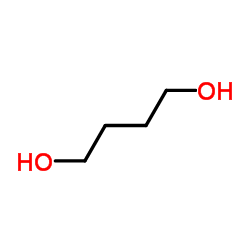
1,4-Butanediol

Specifications
| Trademark | Application | |||
| BDO101(In Bulk) | Mainly applicable to produce polybutylene terephathalate (PBT), γ-Butyrolactone (GBL), polyurethane (PU), tetrahydrofuran (THF), copolyester ether (COPEs), Polytetramethylene glycol ether (PTMEG), N methyl ketone (NMP), polyvinylpyrrolidone (PVP), synthetic vitamin B6, pesticide, herbicide and solvents, humidizer, plasticizer, medical intermediate, chain extender and tackifier, etc. | |||
Packing & Storage
| Packaging | In Bulk | |||
| Storage | Store below +30°C | |||
| Transportation | Sun, rain and mechanical damage should be avoided during transportation. | |||
Free Quote
For samples, pricing, or more information, please call us at 0086 25 51192301 or mail to info@ascent-chem.com or fill out the following form.
We will respond to you as soon as possible.
Tel: 0086 25 51192301
E-mail: info@ascent-chem.com



General Information
Chemical & Physical Information
Safety Information
Synthetic Route
Chemical & Physical Information
| Common Names | 1,4-Butanediol, BDO, 1,4-Butylene glycol, Tetramethylene glycol | |||
| Structure |  C4H10O2 C4H10O2 | |||
| CAS No. | 110-63-4 | Density | 1.0±0.1 g/cm3 | |
| Molecular Weight | 90.121 | Boiling point | 228.0±0.0 °C at 760 mmHg | |
| Appearance | Clear colorless liquid | Melting Point | 20 °C | |
| HS Code | 2905399090 | Flash point | 105.9±13.0 °C | |
| Refractive index: | 1.441 | LogP | -1.02 | |
Safety Information
| Safety Statement (Europe) | S36Xn:Harmful | |
| Risk statement (Europe) | R22 | |
| RTECS Number | EK0525000 | |
| Water hazard class (WGK) | 1 | |
| Hazard Code (Europe) | Xn:Harmful | |
| Hazard category | 6.1 | |
| FIRST AID | |||
| Inhalation | Move the patient to fresh air. If breathing stops, perform artificial respiration. Consult a doctor | ||
| Skin | Rinse with soap and plenty of water. Consult a doctor. | ||
| Eyes | Rinse thoroughly with plenty of water for at least 15 minutes and consult a doctor. | ||
| Ingestion | Never feed anything to the unconscious person. Rinse your mouth with water. Consult a doctor. |
Synthetic Route
| In the first step, acetylene and formaldehyde are placed in a reactor composed of several slurry bed reactors connected in series, using an improved Cu catalyst to react at 79-90°C and 0.12-0.13MPa to form butynediol. After filtration, the catalyst and the reactant are separated and left in the reactor, and the liquid phase material flows out of the reactor to be purified and then enters the lower… In the second step, an improved catalyst is used in the slurry bed, butynediol is hydrogenated at 120-150°C to generate BDO, and finally BDO is purified by distillation and thin film evaporation, and the purity of BDO is ≥99%. |
Frequently Asked Questions
About Us
Ascent Petrochem Holdings Co., Limited is a company specializes in the processing and marketing industry chain of petrochem and coal chemical industry, by persistently pushing forward with high-tech and service innovation. We are committed to becoming China’s best diversified chemical company which focusing on technologies and services.
Contact Us
